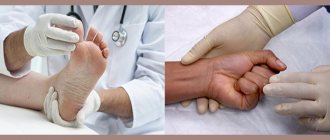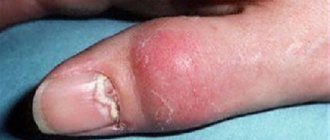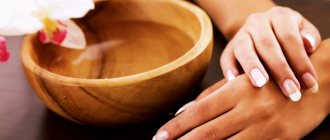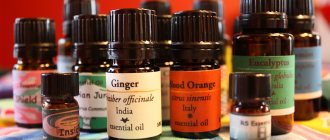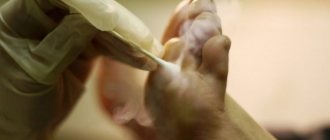Just a few years ago, fungal nail diseases were not given much importance, whereas now everyone understands the need for timely detection and treatment of a massive contagious fungal infection caused by a variety of dermatophyte fungi. Thanks to widespread public awareness, the number of visits to specialists with this pathology has increased, which in turn has led to an increase in the detection of mycoses of the feet. Since any deformation of the nail plate for no apparent reason (for example, injury) is primarily suspected of a fungal infection, self-diagnosis in this case is a decisive factor. Thus, any change in the nail plate is a reason to contact a dermatologist, because at least half of such disorders will have a fungal etiology, and the rest will require careful diagnosis, again carried out by a specialist.
Why, given the obvious simplicity of clinical diagnosis of fungal nail infections, do patients usually come to the appointment already with advanced forms of the disease? Most often, 4-5 toes are affected, with the most affected nail plate (usually the first toe) changed by more than half, and its thickening is about 2 mm. Such symptoms require long-term combined treatment, which is reflected in its cost. Factors leading to this situation:
1. Actually, fungal nail infection is a sluggish disease that does not lead to life-threatening conditions and does not cause pain or discomfort. More often it affects the elderly population, who often associate changes in appearance with the aging process.
2. The sick themselves are often embarrassed by the disease, are not prepared for the financial costs of treatment, or are confident that it is incurable. Many people begin to self-medicate and do not see the disease as a reason to see a specialist.
3. Since the disease primarily affects the feet, even during medical examinations or examinations by doctors, the matter usually does not reach the point of examining the feet directly, without specific patient complaints about changes in the nails. This is facilitated by the extremely short time allotted for seeing patients even in specialized institutions, which, unfortunately, forces doctors to examine them only for the main reason for the visit.
Fungal infection of nails lasts quite a long time
Therefore, the earlier the disease is detected, the higher the likelihood of its complete cure. In addition, an earlier start of therapy allows us to limit ourselves to the use of only external preparations and nail cleanings, and this is only possible if the infection has affected single nails from the distal or lateral edges of less than 1/3-1/2 of the plate. Local external therapy is used to treat the initial stages of fungal nail infection. Advanced forms of fungal infection require longer and more expensive treatment. Periodic preventive examinations and medical examinations of the population play a special role in the early detection of nail mycoses.
How to tell if there is fungus on your nails
Onychomycosis is the medical name for fungal infection of the nails. How to recognize it?
If the nail becomes cloudy and brittle, white spots have formed on it, and the skin around it turns red or begins to itch - these are symptoms, as well as the first stage of the development of the fungus.
During the first stage, the nail will become denser and thicker, and irregularities will appear on it. During the second stage of fungal development, the nail plate will lose its strength and can be easily removed with a scraper. It will begin to gradually move away from the cuticle, and the skin will become inflamed.
If treatment for the fungus is started, the nail will begin to deteriorate and may even move away from the finger.
Causes of pathology
- Frequent nail injuries.
- Wearing tight shoes.
- Diabetes mellitus and other endocrine pathologies.
- Hereditary dysfunctions.
- Psoriasis, lichen planus, ichthyosis, keratoderma, papillomatosis, chronic eczema.
- Imbalance of vitamins and microelements.
- Insufficient hygiene.
- Imbalance of the intestinal genome, including after treatment with antibiotics.
- Unbalanced diet.
- Sleep disturbances.
- Severe stress.
- Allergy to cosmetics.
As a rule, the disease develops against the background of a fungal infection of the nail, often against the background of immunodeficiency.
When can you use baths for nail fungus?
The most common way to treat nail fungus is baths.
If they are carried out during the first stage of onychomycosis, the infection can be cured in a short period - from 2 to 4 weeks.
If more than three nails are affected, treatment will take from 6 months to a year. Neglected nails should be removed and the course continued for 4-8 months.
After the nails return to normal, it is recommended to take baths to strengthen the nails.
Prevention
To avoid the occurrence of the disease, it is recommended to adhere to the following preventive measures:
- in public places, which include a swimming pool, sauna and bathhouse, do not walk without special shoes; observe the rules of personal hygiene;
- do not use other people’s towels to dry your feet and do not wear other people’s shoes;
- regularly take multivitamin complexes to strengthen the immune system and increase the protective forces of the epidermis;
- wear only comfortable shoes made from natural materials and regularly ventilate, dry them, and treat them with antifungal agents.
Recipes
With hydrogen peroxide
For any bath we need a basin. 4 liters of water are poured into it. I remind you that the water temperature should be 40-45 degrees. Then we need to add 150 ml of peroxide. For the bath you need a 3% solution. The duration of the procedure is from 20 minutes.
Vinegar
It is strictly forbidden to use vinegar in its pure form, as this will lead to burns.
For this bath we will need table or apple cider vinegar. You need to choose a natural product, since you shouldn’t expect a regular effect.
Add 100 ml of vinegar (9%) to 2 liters of water. The duration of the procedure is from 20 minutes.
Iodine bath for nail fungus
For this bath you need to add one teaspoon of iodine and a few drops of tea tree essential oil to 2.5 liters of hot water.
This procedure lasts 10 minutes. After it, the feet are wiped dry, and then a drop of iodine is dripped onto each infected nail.
With sea salt
For this procedure, you need to add one tablespoon of sea salt to 2 liters of hot water. After the 20-minute procedure, you need to wipe your feet dry and apply the ointment prescribed by the doctor to the nail.
Soda
For this bath we will need cotton socks.
Dissolve two tablespoons of baking soda in 3 liters of hot water and mix thoroughly. After the procedure, dry your feet and be sure to wear socks.
Herbal
Herbs are contraindicated for pregnant women, hypertensive patients, people with cardiovascular insufficiency and severe kidney pathology, and allergy sufferers.
The leaves of burdock, plantain, wormwood and yarrow should be mixed in equal quantities and poured with boiling water. After this, wait until the water temperature is 40 degrees and immerse your feet in the broth.
Teahouse
For this bath you need a solution in which the kombucha has spent at least a month. This liquid is mixed with hot water at the rate of one tablespoon per liter. The feet are kept in the bath for 15 minutes.
This procedure must be done every day for 2 weeks.
Soapy
2 tablespoons of tar soap should be crushed using a grater and then dissolved in 2 liters of hot water. Immerse your feet in the solution for 20 minutes. After the procedure, dry them with a towel.
Garlic
To prepare, you need 3-4 cloves of garlic and a blender (you can use a grater or mortar). Place chopped garlic in 1-2 layers of gauze and squeeze thoroughly. Rub the resulting juice into infected nails 1-3 times a day.
With propolis
This bath is prepared using 1 teaspoon of propolis tincture (20%) per 1 liter of hot water. The feet are kept in the solution for 20 minutes, and then the surface of the nail plate is cleaned with a file, its edges are trimmed with scissors. After this, a fresh propolis cake is used to continue treatment.
Rules of application
The sooner a girl detects a fungal infection, the higher the chance of treating it without further spreading to sensitive skin, as well as other fingers.
The fungus has three stages of development: initial, active and neglected. In the first form, nails can be cured using only folk recipes, for the second, external medicinal treatment is prescribed, and the advanced form can be eliminated only by an integrated approach, for which the use of antifungals and the application of restorative compounds are prescribed.
Baths for fungus on the feet can be used at any stage of the lesion, as they always ensure the normalization of the nail bed, the restoration of its microflora, the acidic environment that is disturbed by pathogenic bacteria. It is effective because of this, that microorganisms cannot exist in an acidic environment.
In order for the baths to effectively affect the area affected by the fungus, you need to take into account the recommendations for their implementation:
- Procedures must be performed daily without disturbing the treatment regimen.
- It is recommended to carry them out at night, so that during sleep the beneficial microelements remaining on the plate are absorbed into it and act on bacteria.
- The basis for the baths is water, it must first be boiled and cooled.
- The temperature of the solution should be comfortable for the hands - warm, you should not make it cool, since after 15-20 minutes of performing the technology it cools down even more and the effectiveness of the manipulations decreases.
- Baths should take 15-20 minutes or more, since in 10 minutes beneficial microelements do not have time to attach to the surface.
- You must first prepare the surface for manipulation; for this, use an antiseptic, laundry or tar soap.
- After carrying out the technology, excess moisture is absorbed with disposable paper towels (to prevent the fungus from spreading throughout the surface), without rinsing the treated area. After this, it is recommended to apply an antifungal medicine (ointment, spray, medicated varnish).
Despite the fact that the steam bath has a useful antibacterial composition, you need to take into account the recommendations for its use in order to increase the speed of destruction of microorganisms.
Auxiliary components are always added to the solution, which provide an aggressive effect on pathogenic bacteria. This creates a double effect of manipulation: preparing tissues for the application of medicinal compounds, and also has a disinfecting effect.
Before each bath you need to prepare your feet:
- Wash them thoroughly using laundry or tar soap. Absorb moisture with disposable paper towels.
- Use a file to file off the overgrown part of the free edge.
- Grind off the upper stratum corneum, where most of the bacteria are concentrated.
- Remove the sawdust and clean the treated area with an antiseptic.
After this, you can perform a bath, and then apply antifungal medications prescribed by your dermatologist.
Compliance with the recommendations for carrying out the technology and preliminary preparation for it will help increase the effectiveness of the procedures and speed up the period of fungus removal. In the initial form, when complex treatment is performed, it usually goes away in a month, in the active form – in 2 months, and in the advanced form – in 3-4.
What essential oils can be added to baths for nail fungus?
Tea tree oil
You can add tea tree oil to the bath. It perfectly helps get rid of fungus. This oil also successfully destroys bacteria, stopping their development.
Celandine oil
In addition to the fact that this oil has an anti-inflammatory and disinfecting effect, this drug is effective for various dermatological diseases.
Lemon oil
This product creates an antiseptic effect. It cares for nails, penetrating deep into their structure.
Cinnamon oil
Very effective in the fight against nail fungus. If after a bath with the addition of this product you feel a burning sensation and discomfort, you need to dilute it with vegetable oil in equal proportions.
Operating principle
Salt has been used for nail fungus for a long time, as it has a pronounced therapeutic effect against infectious factors. With its help, an active alkaline environment is formed, which promotes the death of pathogenic microorganisms and prevents their spread to healthy tissues.
The components of the salt easily penetrate into the deep layers of the nail and skin, destroying fungal spores from the inside. The product has additional antibacterial activity, preventing the addition of a secondary infection. It also has a keratolytic effect - softens and exfoliates the old stratum corneum.
All types of salt are endowed with the listed properties - both ordinary table salt (sodium chloride), sea salt, and iodized salt. They contain microelements from almost the entire periodic table - at least a hundred different useful components.
A strong salt solution will help a person not only during illness, but also in everyday life. By taking baths based on sodium chloride at least once a week, nails acquire a healthy appearance, become stronger, and most importantly, infectious agents do not have a single chance of survival. That is, salt is also an excellent prevention against nail fungus on the hands and feet.
The effectiveness of salt in advanced stages of fungus
In case of old chronic infection, salt should not be used as an independent remedy. It is impossible to cope with deep damage to the stratum corneum using external methods, especially folk ones. In such a situation, only a systemic approach in the form of antimycotics intended for oral administration can solve the problem.
This is due to the fact that the fungus lives not only in the thickness of the nail plate. If a person refuses to treat a disease for a long time for some reason, infectious agents penetrate inside the body, spreading through the general bloodstream into its individual systems. As a result, local treatment of onychomycosis turns out to be useless, since external preparations cannot affect the pathogen from the inside.
Hardware pedicure
This method is also called mechanical. The procedure requires a special device - a milling cutter, which is used for cosmetic manicure. It has a rotating element and replaceable abrasive attachments. It is important to know that nail removal is not a cosmetic procedure, and a doctor, not a pedicurist, should work with a milling cutter.
- diseases associated with poor blood clotting;
- HIV infection;
- capillary permeability;
- diseases of an inflammatory or infectious nature.
After consultation, foci of infection are identified and removal begins. This is a rather lengthy process: one finger can take half an hour. During treatment, the area heats up from friction, but in general, the procedure is painless. It goes like this:
- the treatment area and the device itself are disinfected;
- A softening compound is applied to the nail, which makes filing easier;
- the doctor sequentially removes the stratum corneum, getting to the root of the infection;
- antifungal and antimicrobial agents are applied.
The big advantage of using hardware is that it saves time: cutting is done once. No anesthesia is required, which means no chemicals. Compared to surgical removal, this is a gentler method and rarely causes bleeding. Since there is no open wound, rehabilitation takes less time and there is no discomfort.
Conservative treatment methods
They are mainly used for uncomplicated ingrown toenails, when there is no pronounced suppuration or persistent invasion of the nail plate into the tissue of the periungual fold. There are many known methods of conservative treatment - tamponade, application of corrective devices (plastic, metal, glued to the nail, in the form of one- and two-sided staples, etc.). In many cases, treatment with all these methods is quite effective. There are also disadvantages. The main ones include the following:
- Duration of treatment – correction of a nail with staples takes weeks and sometimes months, but the result is not 100% guaranteed, and it is possible that in the end you will still need surgery to remove the ingrown nail.
- High price. The corrective devices themselves are not very expensive, but they need to be constantly monitored, which requires repeated visits to a specialist, and, in total, is not cheap.
- The presence and visibility of a brace on the leg (and it needs to be worn for quite a long time and can only be removed at the end of the course of treatment).
- A good effect can be achieved only if the treatment is carried out by an experienced podologist; there are few such specialists, although many undertake to treat with these methods, often without proper knowledge of the technique.
Details about diagnostics
In some cases, in addition to examination and microscopic examination, additional tests may be needed. So, in especially advanced or difficult to diagnose cases, the patient needs to check the function of the liver and kidneys. To do this, you need to donate blood for biochemistry: apartate aminotransferase and anine aminotransferase, creatinine. It is also necessary to exclude hepatitis B and C. Only based on these tests (biochemistry, microscopy and culture), it is possible to prescribe the correct therapy for the patient, which will get rid of the problem once and for all and will not harm the patient. Once every 1.5 months, a biochemical blood test is repeated to monitor drug tolerance. Most often, everything remains normal, but in rare cases of an individual reaction, an increase in indicators may occur. In this case, hepaprotectors are prescribed, the dosage or frequency of administration is reduced, or a lighter drug is prescribed.



